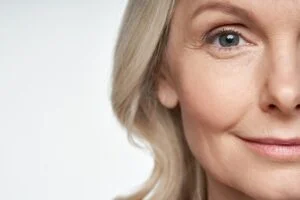Abdominoplasty (Tummy Tuck)
Also referred to as “abdominoplasty,” a tummy tuck is a surgical procedure that can significantly reduce the appearance of a protruding abdomen— whether from loose skin and/or excess fat, loosening of the abdominal muscles (perhaps due to pregnancy), or both. As aging, weight fluctuation, pregnancy, and your own genetics continue to affect the body over time, patients may develop a stretched, loose, or hanging abdominal appearance that diet and exercise cannot improve. Tummy tuck surgery is a powerful procedure performed by our board-certified plastic surgeons to firm, tighten, and smooth the abdomen, often enhancing the overall shape and contour of the abdominal region.
Explore Topics On This Page:

Quick Facts About Tummy Tuck Procedures
- Sedation: General anesthesia (during the procedure); time-release local anesthetic (after the procedure)
- Potential Benefits: A firmer, flatter, and more toned abdomen; reduction of loose or excess skin, torn muscles, and/or unwanted belly fat
- Potential Risks: Swelling, bruising, or (less commonly) bleeding, infection, or negative reactions to anesthesia*
- Procedure Length: Approximately two to five hours
- Recovery: Ten days – two weeks (non-strenuous activity); four to six weeks (intensive exercise)
What Is Tummy Tuck Surgery?
Tummy tuck surgery is designed to remove excess fat and skin, tighten the abdominal musculature, and improve a patient’s contour—potentially even providing greater definition to their abs. The best candidates for abdominoplasty typically have excess, loose skin in the abdominal area that does not respond to diet and exercise. The procedure is also ideal for women who are experiencing abdominal muscle laxity as a result of one or more pregnancies, as well as those who have lost a significant amount of weight and are left with excess, loose skin. Patients who struggle with excess fat but do not have a significant amount of excess skin in the abdominal region may benefit more from liposuction. Alternatively, a patient who has both excess skin and excess fat may benefit from a “lipoabdominoplasty,” sometimes referred to as a “combituck,” which is a modified tummy tuck that includes liposuction of the abdomen at the same time.
Tummy Tuck vs. Liposuction
A tummy tuck and liposuction are both body contouring procedures that can produce a slimmer and improved look in the abdomen; however, while liposuction is designed to simply remove excess fat, tummy tuck surgery is performed to tighten loose skin as well as stretched abdominal musculature. The nature of your concerns can indicate which treatment is able to achieve your aesthetic goals most effectively.
If you are primarily bothered by stubborn fat around the torso and excess skin is not necessarily an issue, liposuction is considered a steadfast procedure to achieve excellent results. A more defined abdominal contour can often be noticed immediately after liposuction and the recovery period is typically not as extensive as other surgical procedures. In contrast, for men and women who have a bulging or protruding abdomen, a tummy tuck may be the best solution to tighten redundant skin and repair abdominal muscles that have been stretched by pregnancy or weight gain and subsequent weight loss. Abdominoplasty can provide a significant improvement in the appearance of your abdomen, but fat removal is typically not a main component of surgery. Therefore, a combination liposuction and tummy tuck procedure, also known as a “lipoabdominoplasty” or “combituck,” can be ideal for patients who would like to correct muscle and skin laxity in conjunction with excess fat. To determine which procedure can best achieve your aesthetic goals, our team can evaluate your concerns in a consultation.
Complementary Procedures to Tummy Tuck Surgery
In addition to liposuction, which is commonly performed in conjunction with abdominoplasty, a variety of procedures can complement this surgery. While both tummy tuck and liposuction are frequently incorporated into customized Mommy Makeovers, abdominoplasty can also be performed alongside breast enhancement procedures like breast augmentation or mastopexy. Additionally, you may wish to enhance your facial aesthetic with facelift, eyelid, or nose surgery (rhinoplasty). Ultimately, you and your surgeon can decide which procedures are best to suit your unique medical needs and aesthetic goals.
What Can I Expect During My Tummy Tuck Consultation?
During your initial consultation, you will have the opportunity to express any and all desires, concerns, and questions about your personalized treatment plan. Your surgeon will work closely with you to prepare you for the next step, reviewing your patient history and examining your overall health in a physical exam. If you so desire, we can show you testimonials and abdominoplasty before-and-after photos to provide a sense of your potential results. Regardless of your individual case, our goal is to make you feel as comfortable and confident as possible at our practice and let you know that your satisfaction is our priority.
What Are My Tummy Tuck Options?
Body contouring surgery of any kind should always be considered in the setting of a healthy lifestyle with proper eating and exercise. That said, if a patient has mostly just loose abdominal skin, stretch marks, and/or loose rectus muscles either from pregnancies or gaining and losing weight, a standard tummy tuck or abdominoplasty may be appropriate. For the patient who has some extra unwanted fat in the abdomen, a lipoabdominoplasty, or “combituck,” might be the better operation (see below). To determine which option is best, it is necessary to be evaluated in person during a thorough consultation. For patients who can “pinch a lot more than an inch” in the tummy area, a standard tummy tuck alone may not be able to achieve the desired results.
Standard Tummy Tuck
A standard tummy tuck is designed for patients who are at or near their ideal weight but who have excess skin around their abdomen. Candidates for a standard tummy tuck may also have an abdomen that protrudes due to stretched or torn muscles. During a standard tummy tuck, excess skin can be removed, the underlying musculature can be tightened or repaired, and patients can achieve a flatter, smoother stomach and lower abdomen.
Mini Tummy Tuck
Some patients have minimal excess abdominal skin, but experience loosened abdominal musculature that only requires the tightening of muscles or the abdominal wall. In this situation, a mini abdominoplasty, or a “umbilical float tummy tuck,” may be enough to tighten the area. A small incision is made below the bikini line and the fibrous band attached to the umbilicus (belly button) is divided in order to allow the muscles to be tightened. The umbilicus is then reattached to the tightened muscles and a small amount of loose skin can be trimmed. Most of the “tightening” occurs on the inside, resulting in an obviously flatter and tighter tummy, especially from a side view. A mini tummy tuck typically results in shorter incisions and an accelerated recovery period when compared to a standard tummy tuck.
Lipoabdominoplasty (Combituck)
Some patients may require both a tummy tuck and liposuction to improve the appearance of their tummy and trunk. This has also been referred to as lipoabdominoplasty, or a “Combituck.” In this procedure, a less extensive undermining of the loose tummy skin is performed, while liposuction is performed over the whole area of the abdomen or torso (sometimes front and back), followed by the skin removal and tightening. The specifics of the surgery are somewhat different in order to ensure a proper and healthy blood supply. Lipoabdominoplasty is a relatively new technique first developed in Brazil that combines both procedures, and one with which Dr. Craig Rowin has extensive experience.
How is the Tummy Tuck Procedure Performed?
Most tummy tuck procedures begin with as short an incision as possible, made directly above the pubic area between the hips in the natural transition zone between the tummy and pelvic area. The location of the incision is placed so that it may be easily concealed by a swimsuit or underwear, and the incision is designed to remove a prior C-section scar whenever possible. Dr. Rowin can then tighten any stretched or torn abdominal muscles before pulling the skin taut and removing any excess. The umbilicus (belly button, or navel) is then sutured into its natural position. For patients who are better suited to undergo lipoabdominoplasty, liposuction will be performed before the skin is redraped. Depending on the extent of work needed for the procedure, abdominoplasty surgery may last anywhere from two to five hours.
Dr. Rowin made me feel so comfortable in my consultation AND procedure. I went in knowing exactly what to expect. The staff answered all my questions when I called in, and were very patient with me even though I was very nervous. The day after my procedure, Reba called to check on me which I have never had an office do. I will definitely be coming back if I need another procedure, and would recommend their office to anybody!
What is Tummy Tuck Recovery Like?
The most common expectations following abdominoplasty include mild swelling and bruising, and the need to walk with a slight bend at the hips and knees for a few days after surgery. There is some post-operative discomfort, but Dr. Rowin or Dr. Kalus will inject a long-acting time-release local anesthetic that will leave their patients almost pain-free for up to 72 hours after surgery. Any breakthrough post-operative discomfort can be controlled with medication, usually a non-opioid unless absolutely necessary as a last resort. These symptoms normally last no longer than 10 days. Patients are encouraged to begin early ambulation immediately after their surgery in order to avoid the risk of developing blood clots. Our plastic surgeons may recommend that patients wear a compression garment during the first stages of recovery to minimize swelling. Most patients will feel 75% recovered within three weeks and 95% recovered by six weeks. Most patients can return to a normal daily activity level within ten days to two weeks, but exercise should not begin for approximately four to six weeks following surgery.
How Long Do Tummy Tuck Results Last?
The results of the tummy tuck procedure can be best maintained by eating a nutritious diet and exercising regularly. While it is considered safe to have children after a tummy tuck for most patients, future pregnancies may compromise the long-term results of the procedure. To achieve the best long-term result. Dr. Rowin typically recommends that women complete their families before pursuing tummy tuck surgery. By keeping a stable weight, patients can help ensure their tummy tuck results last for many years.
What Will My Tummy Tuck Scars Look Like?
Abdominoplasty scars generally extend from hip to hip and exist low on the pubis. Although scars from tummy tuck surgery are unavoidable, Dr. Rowin takes every measure to place incisions in such a way that any resulting scars are well-hidden under most types of clothing, including swimsuit bottoms and undergarments. He disguises incisions within the natural creases of the abdomen whenever possible. Patients usually find that their scars flatten and fade to some degree over time, and do not mind the presence of post-surgical scars in light of the benefits of the procedure. Our office will also provide in-depth instructions detailing how to best care for your incisions post-operatively to foster an optimal healing process.
How Much Does a Tummy Tuck Cost?
Each tummy tuck procedure is customized to meet the unique needs of the patient. The exact price of a tummy tuck will be influenced by factors such as the technique used during the procedure, the degree of skin and/or fat that needs to be removed, and the length of surgery. At the end of the initial consultation, a member of Dr. Rowin’s and Dr. Kalus’ team will quote you a price estimate for the cost of your tummy tuck based upon your specific custom-tailored treatment plan. Some patients prefer paying for their tummy tuck in small monthly installments, an option that is possible through CareCredit®, our third-party financing company. CareCredit® is frequently used for cosmetic treatments and allows qualified patients to select from an array of low- to no-interest payment plans. Our practice will be happy to talk with you about the variety of payment options available that can make tummy tuck surgery as financially feasible as possible.
Pregnancy After Tummy Tuck
Although pregnancy is still possible after abdominoplasty, our plastic surgeons recommend pursuing a tummy tuck after your plans for having children are complete. Because the changes caused by childbearing include increased skin laxity, as well as the stretching of abdominal muscles, pregnancy after a tummy tuck can cause many of the same concerns that patients originally sought to correct with their abdominoplasty, potentially compromising their final results.
Can I Get a Non-Surgical Tummy Tuck?
While there is no non-surgical equivalent to abdominoplasty, there are certain treatments that can improve some of the individual concerns often addressed with a tummy tuck. Depending on a patient’s needs, the procedure generally addresses three components: abdominal muscles, loose skin, and excess fat. Although there is no treatment that can repair stretched abdominal muscles without surgery, redundant skin and fat can be somewhat improved with the medical spa services at Plastic Surgery of the Carolinas.
For the removal of excess fat deposits, CoolSculpting® can help reduce fatty tissue on the abdomen and hips, often resulting in a leaner appearance. This incision-less technique delivers cold temperatures to fat cells without damaging any surrounding tissue, allowing the targeted fat cells to be destroyed by natural metabolic processes. Additionally, if loose skin is present, treatment with TriPollar® utilizes radiofrequency (RF) technology to stimulate the growth of new collagen and elastin fibers. This method of skin tightening can lead to decreased skin laxity and a smoother abdominal contour. While the results achieved by both treatments will not be as effective or long-lasting as a tummy tuck, our team of physicians and aestheticians can help devise an ideal treatment plan based on your unique concerns.
Additional Tummy Tuck FAQs
What is the best age to have a tummy tuck?
The ideal age to undergo a tummy tuck will depend on your individual case. With that said, as stated earlier, our surgeons typically advise patients to complete their families before pursuing a tummy tuck, as pregnancy and childbirth may cause the very concerns that you sought to reduce in the first place (i.e. stretched muscles, loose skin, and excess fat) to return. Keep in mind, however, that everyone’s situation is different, and if you are interested in a tummy tuck, our surgeons would be glad to weigh your options with you.
How long does swelling last after a tummy tuck?
Swelling after tummy tuck surgery can last as long as three months after your procedure. This is completely normal and most swelling should subside within the first couple of months. The best way to reduce inflammation and accelerate the healing process is to follow the aftercare instructions provided by Dr. Rowin and Dr. Kalus. Simple tips that can help decrease swelling include refraining from alcohol and smoking, as well as maintaining a healthy diet of fruits, vegetables, greens, protein, and antioxidant-rich foods. In addition, Dr. Rowin and Dr. Kalus usually prescribe Arnica and Bromelain as homeopathic adjuncts to help reduce post-operative bruising and swelling.
What is seroma after tummy tuck surgery?
A seroma is a buildup of fluid under the surface of the skin, which can occur after any surgical procedure in which tissue was removed. Seromas can develop soon after surgery, or within a few weeks of the procedure as the fluid (serum) accumulates. In most cases, a seroma resolves on its own as the fluid is reabsorbed by the body. However, if you have a seroma that is larger, treatment may be required.
How long should I wear a compression garment after a tummy tuck?
You should wear your compression binder or garment for approximately six weeks after tummy tuck surgery, or until instructed otherwise by Dr. Rowin and Dr. Kalus. A compression binder can not only help reduce swelling and fluid retention after your procedure, but it should also help you achieve your new body contour sooner.
What should I eat after a tummy tuck?
Nutritious foods that are high in antioxidants and vitamins can best facilitate the healing process and decrease post-surgical swelling. It is typically helpful to limit salt intake and include as many fresh fruits and vegetables in your diet as possible. Your plastic surgeon will give you additional instructions before and after your procedure.
How soon after tummy tuck surgery can I swim?
Because getting the treatment area wet too soon can compromise recovery and results, we typically advocate that patients wait to go swimming for two weeks to a month after abdominoplasty.* In most cases, this gives the incisions enough time to fully heal.
Is tummy tuck surgery safe?
When performed by a board-certified plastic surgeon, tummy tuck surgery is generally considered very safe. Our surgeons at Plastic Surgery of the Carolinas are board-certified and experienced, having performed countless successful tummy tuck procedures. During your initial consultation, Dr. Rowin or Dr. Kalus will discuss the likely outcomes and potential complications of tummy tuck surgery.
Is tummy tuck surgery a substitute for proper diet and exercise?
While tummy tuck surgery can remove a certain amount of excess skin and fat (via liposuction), it is not a substitute for dieting and exercise. A tummy tuck is not intended to be a weight-loss surgery. Though treatment can make your abdomen look slimmer and more toned, our team recommends that you follow a healthy diet and exercise regimen after your procedure to avoid weight fluctuations that can compromise your results.
Can tummy tuck surgery get rid of stretch marks?
A tummy tuck procedure is not designed to eliminate stretch marks; however, if there are any stretch marks located on the skin being excised, usually the skin below the belly button, it is possible that the stretch marks can be removed as well. For stretch marks that appear outside the treatment areas, Dr. Rowin or Dr. Kalus can discuss other cosmetic solutions that can help you achieve your ideal goals.
Can tummy tuck surgery get rid of a C-section scar?
A tummy tuck surgery can eliminate a previous C-section scar; however, like any surgical procedure that involves incisions or sutures, there will be scarring from the tummy tuck procedure as well. Incision placement for a tummy tuck is typically below the previous C-section scar, allowing the surgeon to remove the old scar completely along with any excess skin. Our surgeons are highly trained and are mindful of where they make incisions. Any tummy tuck incisions are often placed in discrete locations that can easily be hidden by clothing.
What is a dog ear deformity?
A “dog ear deformity” can occur after surgery and is often described as bunched up excess skin at the ends of a surgical scar. They tend to be triangular-shaped and resemble dog ears, which is how it got its name. This deformity can develop after a tummy tuck procedure if the incision was made too short. As swelling goes down during the recovery process, dog ear deformities usually start to subside. In cases when the dog ear deformities do not dissipate, patients can undergo a minor revision procedure after the initial swelling has gone down.
How do I choose the right surgeon for tummy tuck surgery?
As tummy tuck surgery is a major cosmetic procedure, patients should make sure to put their care in the hands of a qualified, reputable provider. Doing so can help ensure not only top-quality effects, but increase chances of a safe and successful surgery.
As such, we strongly advise you to do thorough research into your prospective surgeon’s background, results, and reputation. It is usually a good idea to comb their website for before-and-after photos, testimonials, and information about the techniques they offer. Moreover, the surgeon should always offer an initial consultation wherein they welcome questions. During this first meeting, you should make sure you feel comfortable with the surgeon and trust them to safely guide you through your experience at their practice.
If you are considering a tummy tuck procedure or other body contouring options, please contact our office to schedule a consultation with Dr. Rowin or Dr. Kalus. We will be happy to answer any questions you may have!



